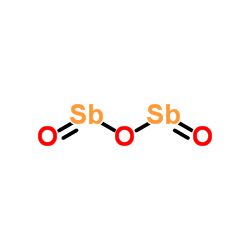Pyrolysis of waste electrical and electronic equipment: effect of antinomy trioxide on the pyrolysis of styrenic polymers.
W J Hall, T Bhaskar, N M M Merpati, A Muto, Y Sakata, P T Williams
Index: Environ. Technol. 28(9) , 1045-54, (2007)
Full Text: HTML
Abstract
This work has investigated the effect that antimony trioxide has on the pyrolysis of styrenic polymers and the effect that different types of brominated flame retardants used in plastics have on the composition of the pyrolysis products. Brominated high impact polystyrene (Br-HIPS) which contained either 5% or 0% antimony trioxide and either decabromodiphenyl oxide (DDO) or decabromodiphenyl ethane (DDE) was pyrolysed in a fixed bed reactor at 430 degrees C. Some experiments on the fixed bed reactor involved mixing the Br-HIPS with polystyrene. The gaseous products were analysed by GC-FID and GC-TCD and it was found that antimony trioxide caused an increase in the proportion of ethane and ethene and suppressed the proportion of butane and butene. When DDE was the flame retardant increased proportions of ethane and ethene were found in the pyrolysis gas compared to when DDO used. When polystyrene was mixed with the Br-HIPS it suppressed the trends observed in the gas composition during the pyrolysis of Br-HIPS. The pyrolysis oils were characterised using FT-IR, GC-MS, GC-FID, and GC-ECD. It was found that the plastic which did not contain antimony trioxide pyrolysed to form mainly toluene, ethylbenzene, styrene, cumene, and alpha-methylstyrene. The oils produced from the pyrolysis of the plastic that contained antimony trioxide did not contain any styrene or alpha-methylstyrene, but instead contained greater concentrations of ethylbenzene and cumene. The absence of styrene and alpha-methylstyrene from the pyrolysis oil occurred even when the Br-HIPS was mixed with polystyrene. GC-ECD analysis of the oils showed that the plastics which did not contain antimony trioxide pyrolysed to form (1-bromoethyl)benzene, which was totally absent from the pyrolysis oils when antimony trioxide was present in the plastic.
Related Compounds
| Structure | Name/CAS No. | Molecular Formula | Articles |
|---|---|---|---|
 |
Diantimony trioxide
CAS:1309-64-4 |
O3Sb2 |
|
Dermatitis in workers exposed to antimony in a melting proce...
1993-04-01 [J. Occup. Med. 35(4) , 392-5, (1993)] |
|
Characterization of pyramidal inversion boundaries in Sb2O3-...
2007-05-01 [Acta Crystallogr. A 63(Pt 3) , 229-33, (2007)] |
|
Biovolatilization of antimony and sudden infant death syndro...
1998-04-01 [Hum. Exp. Toxicol. 17(4) , 231-8, (1998)] |
|
Comparison of clastogenic effects of antimony and bismuth as...
1993-01-01 [Biol. Trace Elem. Res. 37(2-3) , 281-92, (1993)] |
|
Failure of antimony trioxide to induce micronuclei or chromo...
2007-03-05 [Mutat. Res. 627(2) , 119-28, (2007)] |